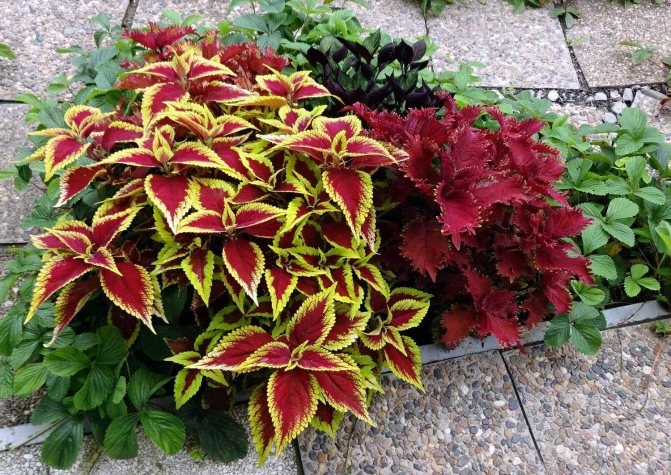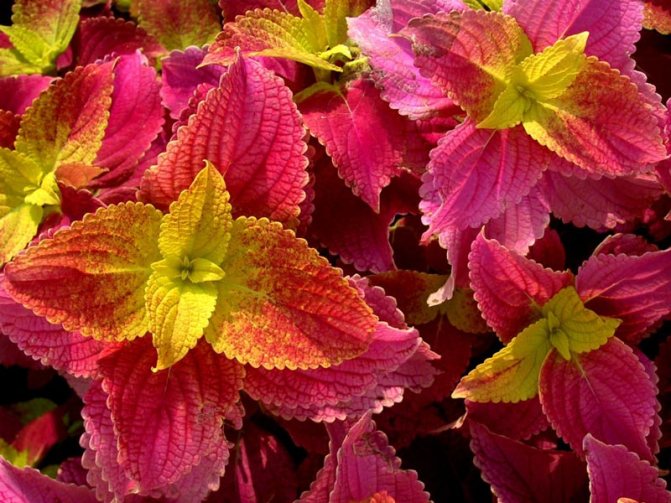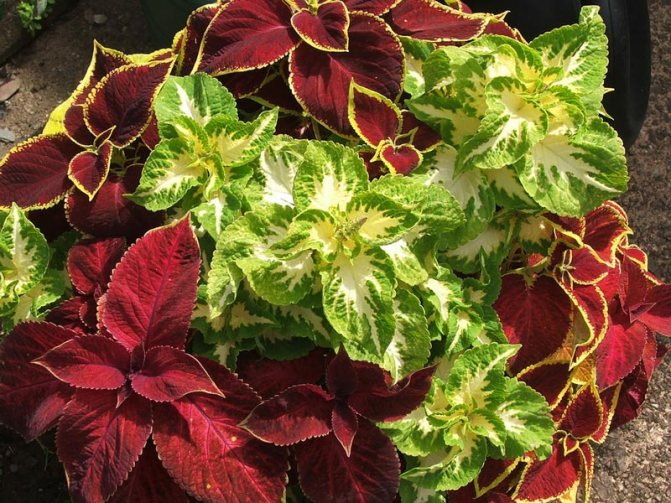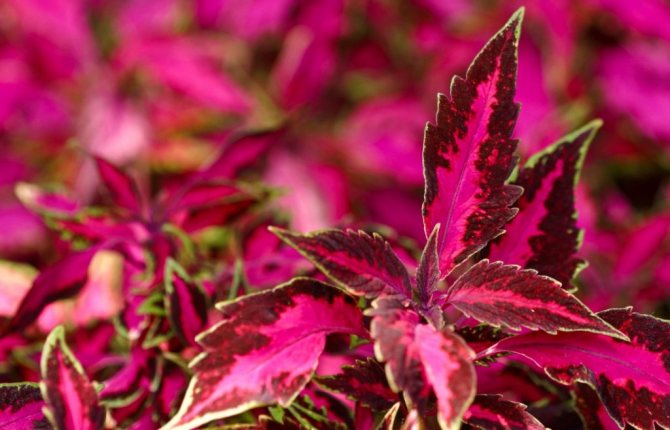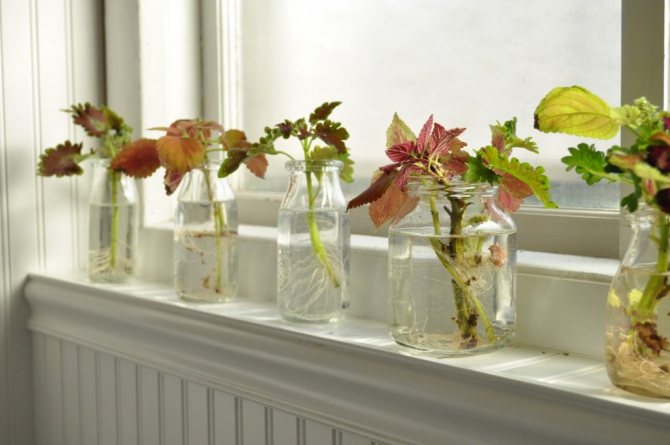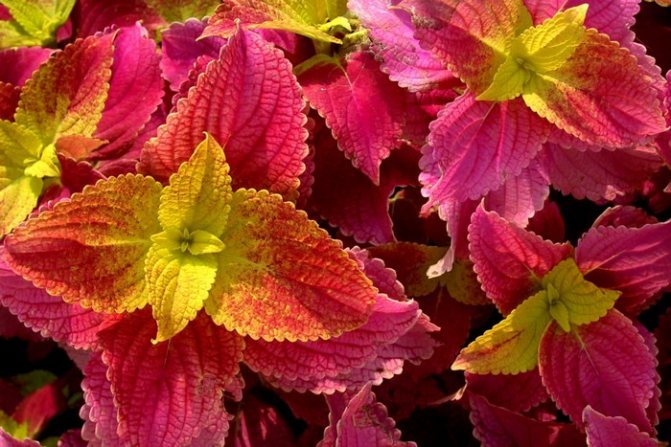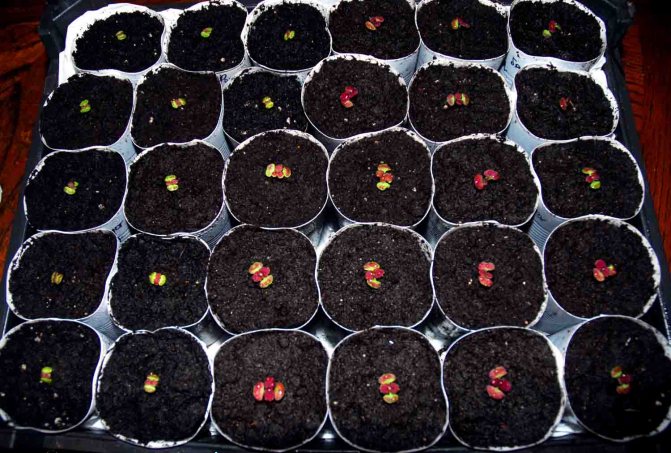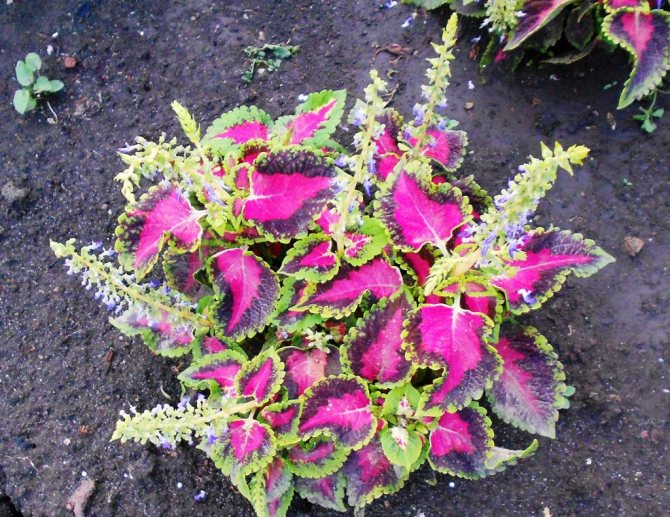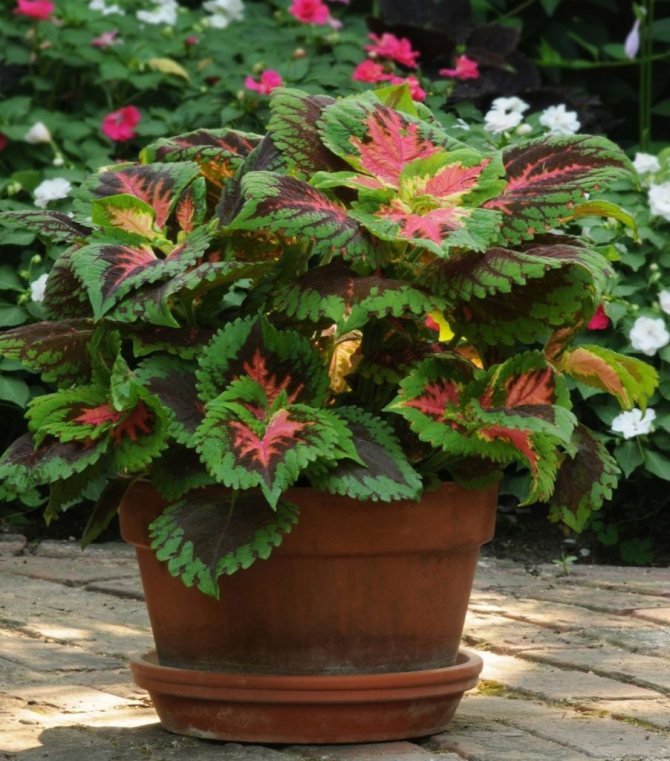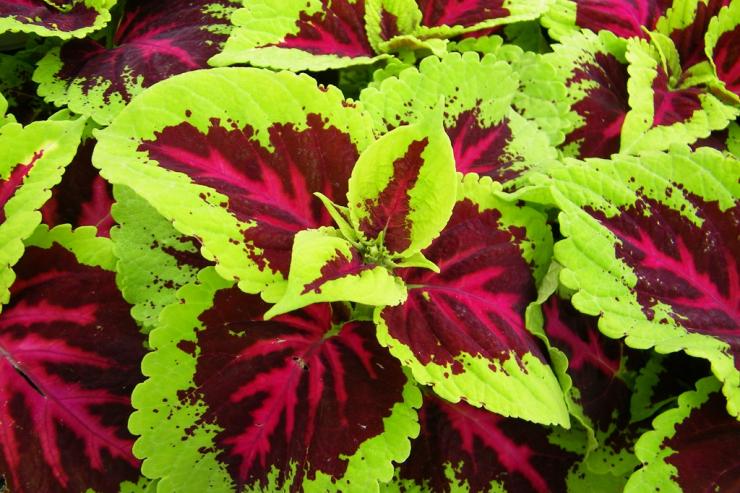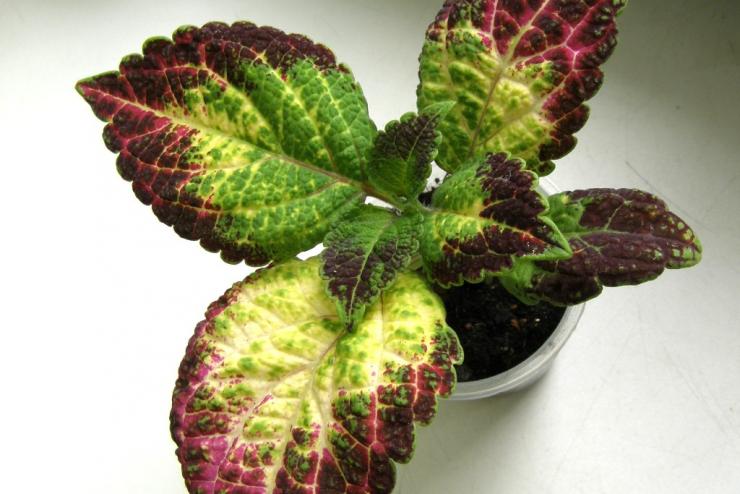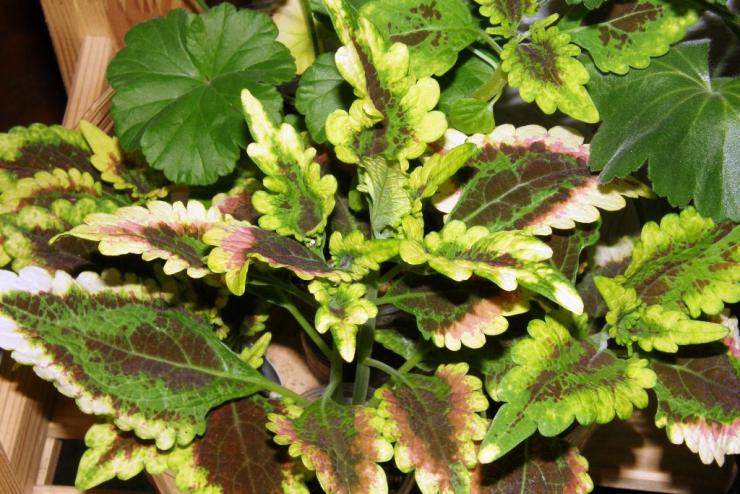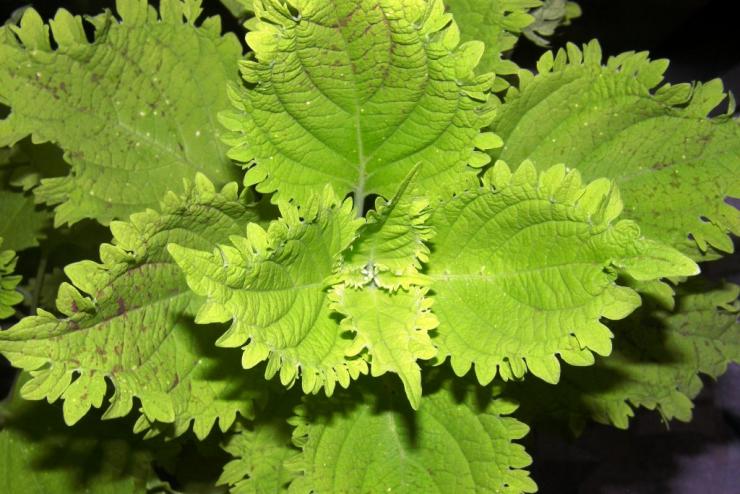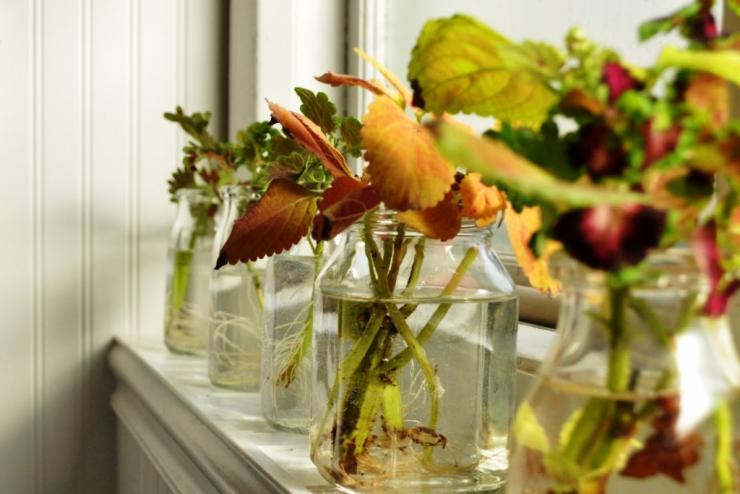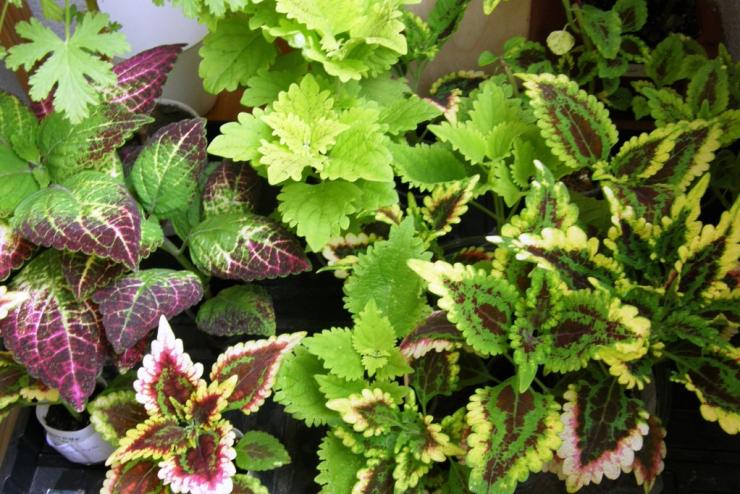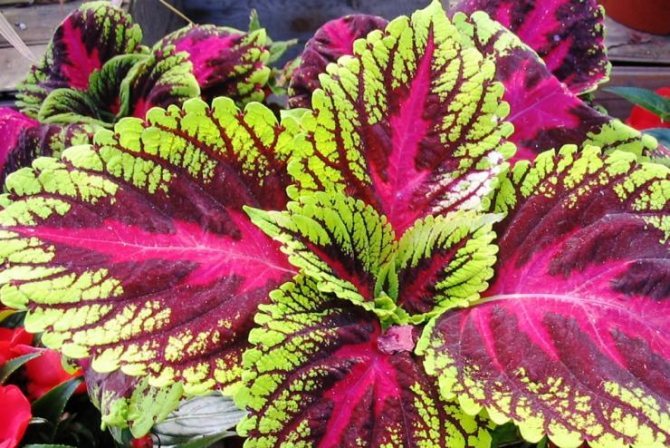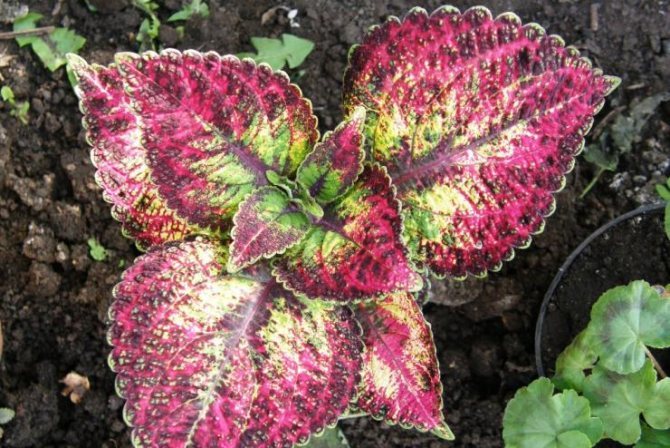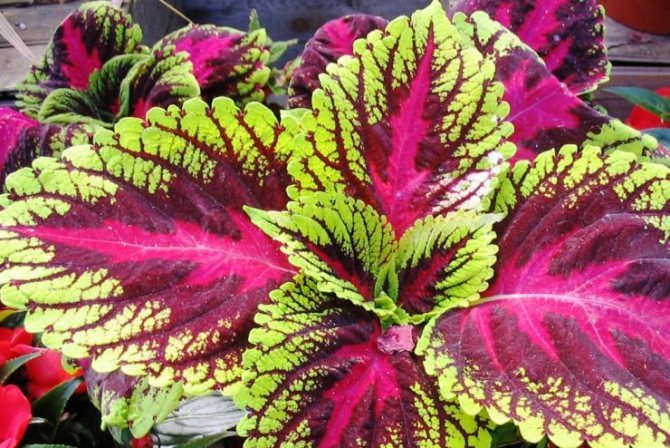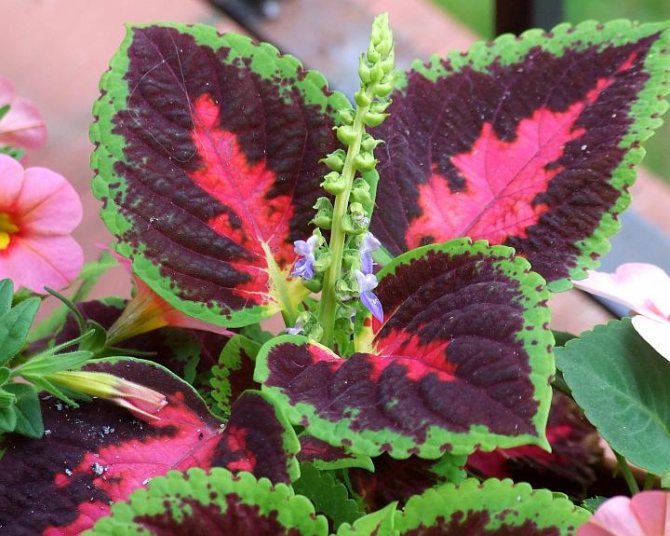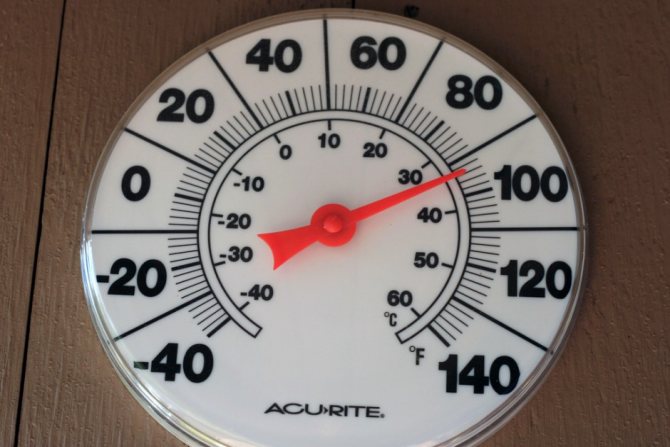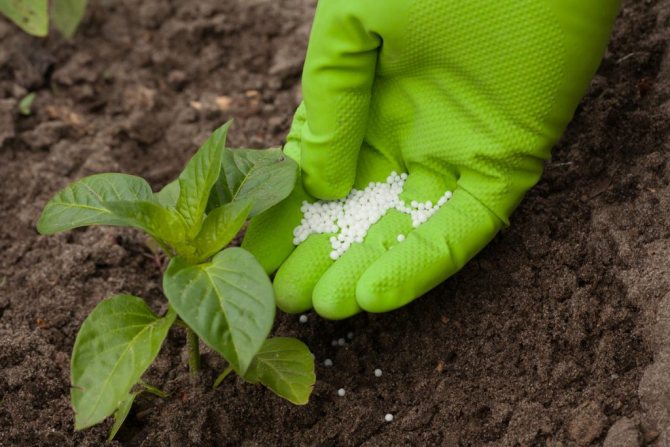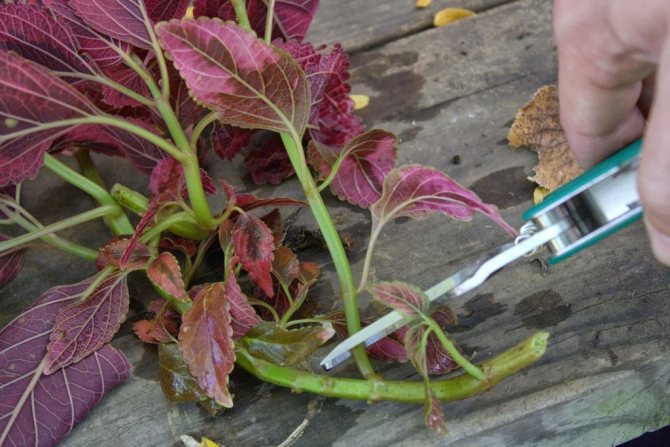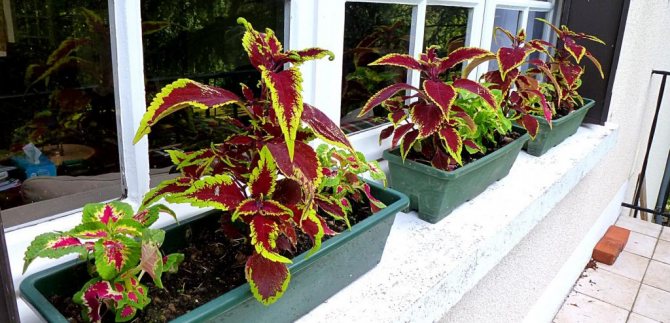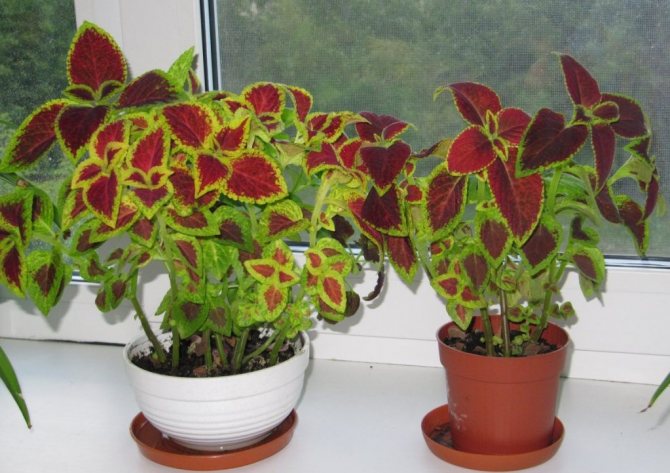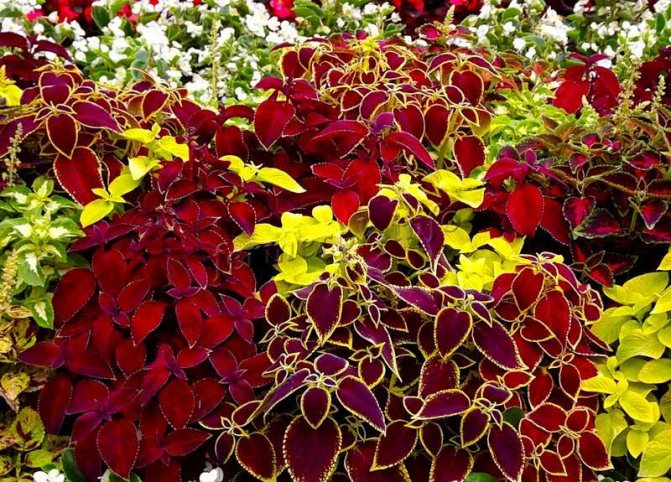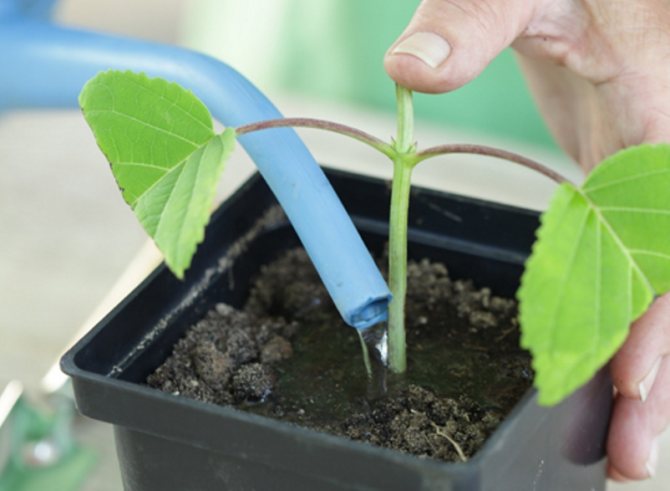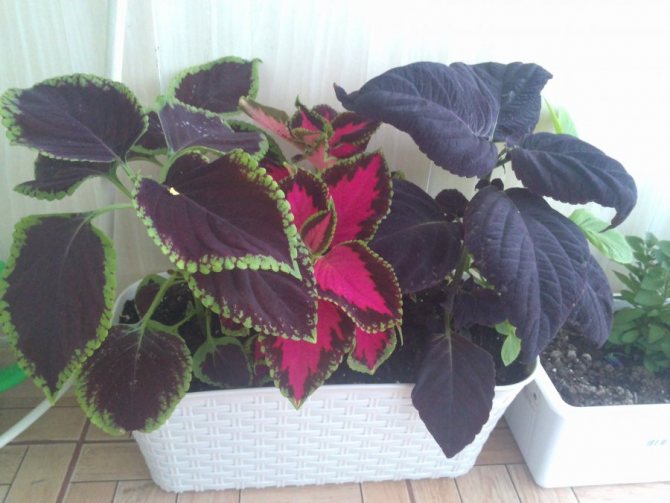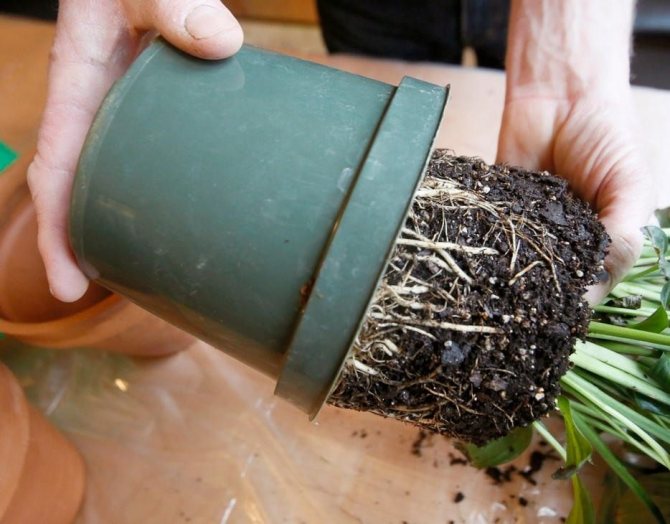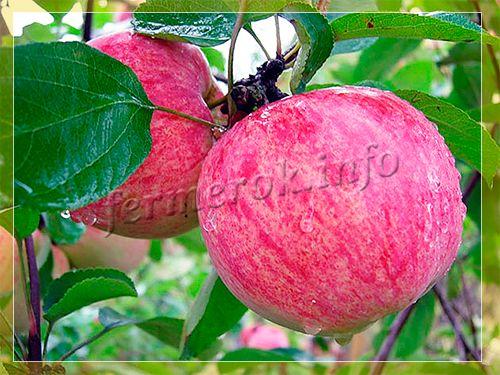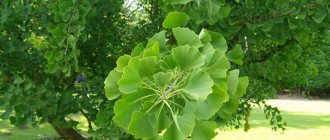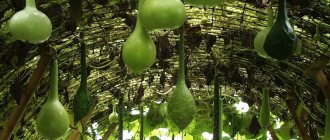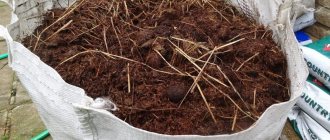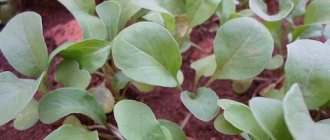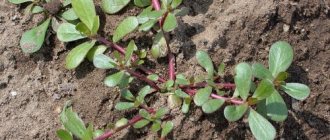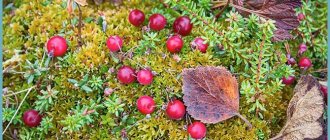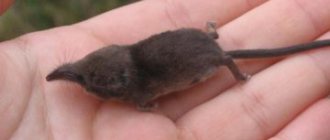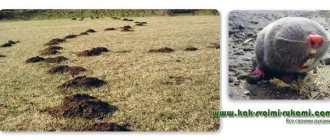Coleus Blume, or Coleus Blumei, or the poor man's croton, belongs to the Lamiaceae family. After studies of plant DNA in taxonomy, the genus "Coleus" was replaced by the genus "Plectranthus", taking into account our habits, these important ornamental plants are described in the article under the old name, especially since the national name has not changed and it is still called Coleus.
Coleus Blume has a tetrahedral, fragile, branched stem, often branches from below, in new varieties it is also colored. In late summer, lignification can be observed in the lower part. The leaves are arranged in pairs crosswise, velvety to the touch due to the covering hairs. Leaves are the main decoration of Coleus due to their contrasting color. Given the similarity in shape and arrangement of leaves, the plant is called nettle. Inflorescence, complex spike, appearing at the top of the shoot and lateral branches. Individual flowers are inconspicuous, it is better to remove so as not to weaken the plants. Leave flowers only for seeds.
It should be noted that not a 3 meter high botanical species is grown, much lower and much more interesting colored hybrid varieties. Thus, the name coleus hybrid (Coleus x hybrida) is justified.
Hybrid varieties do not have a pronounced abscission of the lower leaves, and lignification of a part of the stem. Coleus loses its attractiveness, is grown as an annual. To be sure, leave the pot on the windowsill in the fall and store until spring. In nature, Coleus Blume is a perennial plant.
There are many varieties, you can plant the entire garden with single specimens, several new varieties are created every year.
How and where does it grow?
The flower is a perennial plant. Coleus can grow from 20 to 60 cm in height.Sometimes there are giants reaching 100 cm.
The shape of the leaf blades looks like nettle leaves. That is why the second name of the coleus plant is nettle.
Depending on the variety, the leaves are crescent or oblong. Their color may vary.
There are pink, purple, yellow, burgundy, purple, brown shades.
The leaf mosaic is striking: you can see varieties with striped, spotted and multi-colored leaves.
Types of nettles also differ in the type of inflorescence. As a rule, they are small, they can be white, blue, purple.
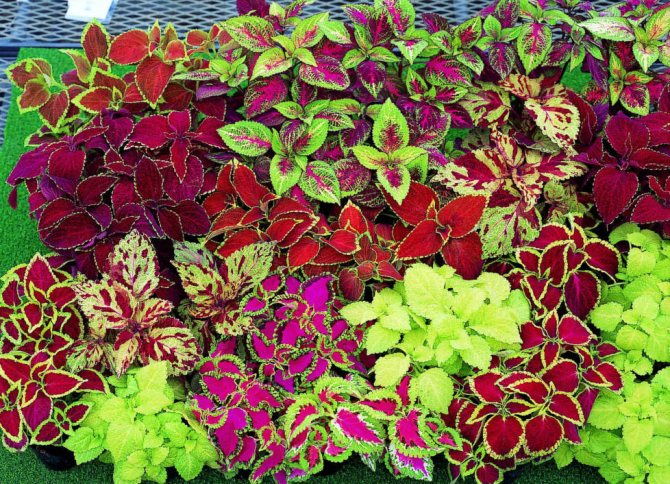
Breeders have also bred varieties suitable for indoor cultivation. In addition, there are annual and perennial plants.
Some hybrids are not only attractive in appearance, they also have a pleasant aroma.
The plant is distinguished by its medicinal and useful properties; Coleus has a bactericidal effect.
Growing coleus by cuttings
Growing coleus by cuttings is easier. The stalk is placed in water until the roots appear, and then the plant is planted in a pot with soil
Growing cuttings in peat tablets.
But the most convenient way of grafting is growing in peat tablets. Before planting, the tablet is filled with warm water, after a while it turns into a cylinder. Now you need to carefully stick the stalk into the groove made with a stick. Put a tablet with a handle in a low container and add water to the bottom until roots appear.When the root system is sufficiently developed, it will be necessary to cut the mesh holding the tablet shape and stick everything into the pot prepared for the plant.
Breeding methods and features of planting Coleus
There is nothing difficult in the question of breeding Coleus - there are two ways.
The first of them is sowing seeds for seedlings, the second is grafting.
Each gardener chooses the most suitable method of flower propagation for him. After all, any of them is so simple that even beginners in this business will be able to do it.
Seed propagation
The optimal time for growing from seed is the end of March.
The correct seeding process is carried out as follows:
- Drainage is poured into the bottom of the containers (boxes, pots, plastic cups).
- Fertile soil is poured on top. You can buy it in specialized stores.
- Then the earth is watered and seeds are laid on the surface.
- It is recommended to lightly sprinkle them on top with sand and moisten from a spray bottle.
- The containers are covered with glass or foil.
- In order for seeds to germinate, they need warmth and moisture. That is why containers are removed where the air temperature is not less than +20 + 25 ° С.
- The first shoots will not appear very quickly. This will take approximately 7-10 days.
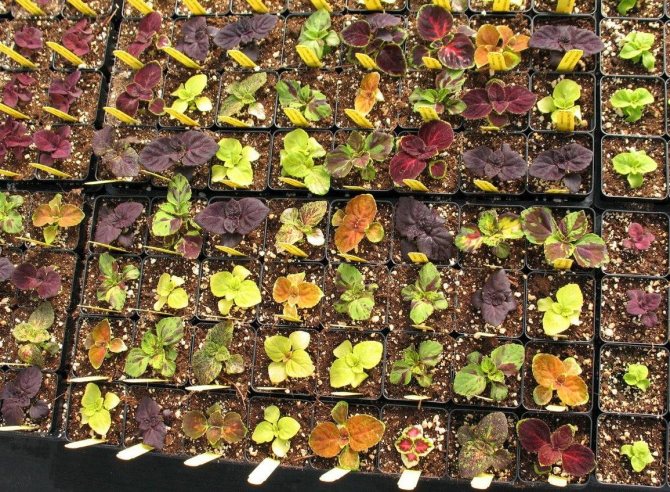

Once the sprouts have emerged, they need a lot of sunlight. The containers are transferred to a windowsill or other place where there is enough light.
Pay attention to the cold air blowing from the window. Otherwise, there is a risk of freezing the seedlings that are not yet strong.
At this stage of development, it is important to maintain a temperature of + 18 ° C. Lack of light and high temperatures will cause the seedlings to stretch out.
Coleus is planted in a permanent place at about the age of 1.5-2 months. During all this time, the seedlings need to be watered regularly.
In addition, if the sprouts are planted too often, they must be dived into separate containers.
If this is not done, the seedlings will not be able to form a powerful root system.
Growing from seeds in peat tablets
In addition to growing seedlings in containers, gardeners often use other means.
For example, you can get Coleus from seeds, which are placed directly into peat tablets.
In order to do this, you must follow the instructions:
- Peat tablets are poured so that they become moist. The compressed peat begins to swell. The tablets increase in size - they become several times larger.
- If watering was abundant, it is necessary to remove excess moisture.
- The planting material is spread over the surface, leaving small gaps between the seeds. Then they are lightly pressed into the soil.
- The tablets are placed in a tray and covered with foil.
- Place the container in a warm place until the seeds germinate.
When growing with peat pellets, the most important thing is to keep them dry. Drying of peat is also undesirable.
It is necessary to regularly check the condition of the tablets and moisten them approximately once every 3-4 days.
Propagation by cuttings and further care
A fairly simple way is to propagate the Coleus by cuttings. You can start it from the end of February until the first days of April.
For this method, it is necessary to prepare cuttings with a length of at least 10 cm. It is recommended to choose a strong shoot.
He needs to break off the lower leaves. Then it is placed in a container with water or earth.
In the first method, it is important to avoid direct sunlight. Also, the water must be regularly changed to clean. It is changed about 1 time in 3 days.
The procedure is repeated until roots appear.
Adding root formation stimulants to the container with water and cuttings will help speed up the process.
It can be Kornevin or Gumisol.
The use of vermiculite has also proven itself well.
It is simply poured into a container with water and stirred thoroughly, then the cutting is dipped into the solution. After the roots appear, they are transplanted into a pot.
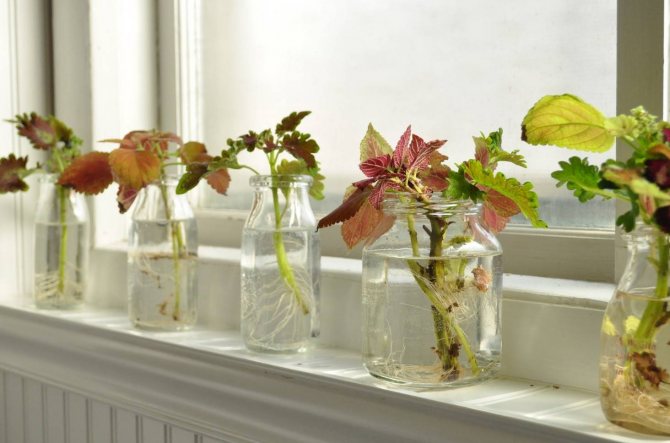

If the cuttings are placed in the ground for rooting, then it is recommended to cover them with a film.
The air temperature should be about + 20 ° С.
The roots will begin to grow back in 7-10 days.
After that, the seedling is ready for transplantation to a permanent place of growth.
Experienced gardeners recommend grafting towards the end of summer.
This will allow you to propagate the flower, grow it for flower beds, flower beds, or use it as a houseplant.
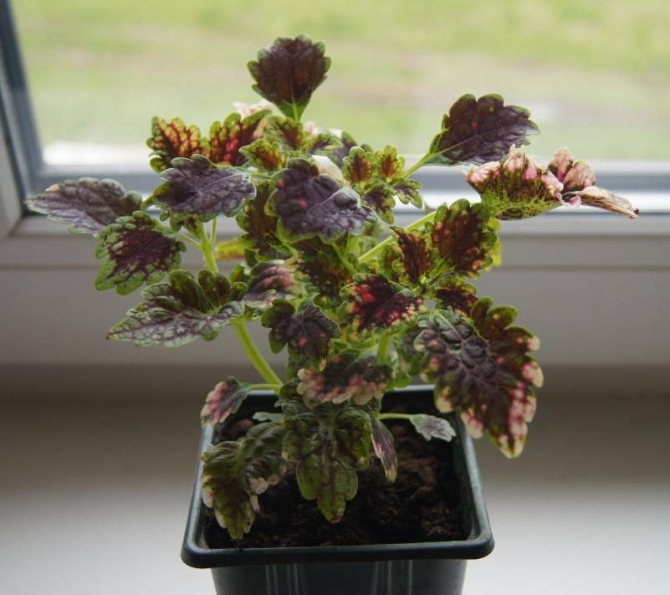

As for an already full-fledged flower with foliage and a powerful root system, it needs some care. Coleus loves the sun.
If it receives a lot of light, its foliage will be colorful, and its pattern will be crisp and bright.
If possible, it is recommended to put the flower pot in a sunny place in the morning, and transfer it to the shade at lunchtime.
Such a measure is necessary for the active growth and development of the plant. Watch the Coleus closely. Sometimes it happens that he begins to shed some of the leaves.
This is due to a lack of sunlight.
Be sure to find a more suitable sunny spot for him.
Reproduction
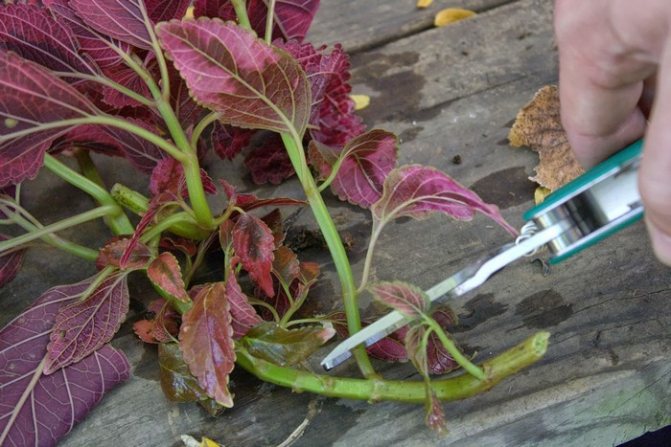

Coleus can be propagated by cuttings or grown from seeds.
When self-compiling seedlings, it should be remembered that herbaceous cuttings are harvested from mother plants that have overwintered preferably in a greenhouse (a lot of light) with a temperature of 15-18 ° C. An increase in temperature in February-March to 20-23 ° C stimulates the growth of new shoots. The secret to fast rooting is to cut the apical cuttings in the middle of the internode. Since the plant is cut just above the knot, the bottom should be cut, not less than a centimeter below the knot. Rooted in a mixture of 70% perlite, the rest is peat. Given the looseness of the substrate, it is recommended to plant in one container. Only after the roots appear, remove the substrate from the container, and put the cuttings with intact roots in the pots. Rooting in perlite has a plus in comparison with rooting in water - plants do not need to adapt from an aquatic environment to a soil environment, it lasts several days, unprotected plants die easily. After hardening, coleuses are planted in beds, flower beds or containers in the second half of May. Coleuses tend to branch, pinching cuttings or seedlings enhances the process.
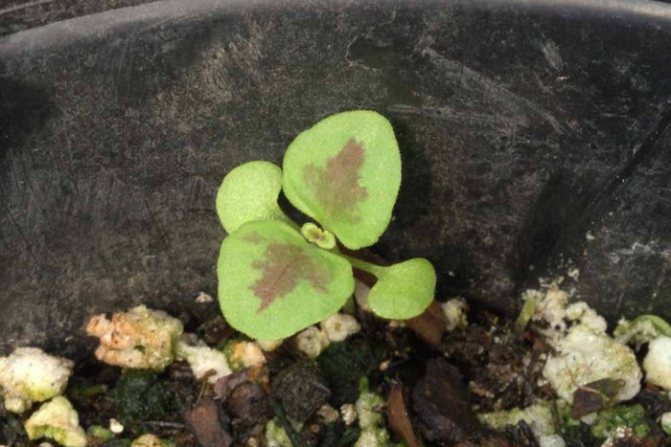

Conditions of maintenance and care of seedlings
When the first shoots appear, it is important for them to provide proper care.
In this case, the grower will receive a strong and healthy adult plant in the future.
Location and lighting
The Coleus flower is considered a light-loving plant. He needs sunlight in the first stages of development, when the root system and the aerial part of the flower begin to form.
When growing at home, it is recommended to put containers with nettles on the western or eastern windows.
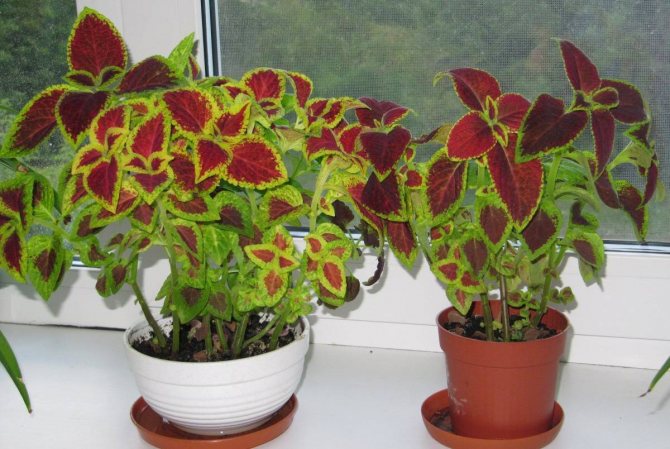

The only thing to consider is the plant variety. Some types of Coleus need regular lighting, while others do well without it.
You can determine whether a flower needs light by its appearance. For example, if there are green spots on the leaves, direct sunlight is contraindicated for it.
If the variety is distinguished by bright colors, then it is better to place the container with Coleus in a sunny area.
Picking sprouts
When growing coleus for seedlings, with the appearance of a second pair of true leaves, it is time for a pick.
Correct transplanting of seedlings:
- Separate pots are prepared (boxes, cups or other convenient container), drainage is poured onto the bottom.
- The soil mixture is poured, which can be purchased at any flower shops.
- It is recommended to water containers with seedlings a couple of hours before picking. This is necessary for the earth to become soft.Thus, the seedlings can be easily removed without damaging the thin roots.
- After that, individual sprouts are placed in pots to a depth of 7 cm. Sprinkle with earth on the sides, compact and watered.
- After about 30 days, they are transplanted into large-diameter containers.
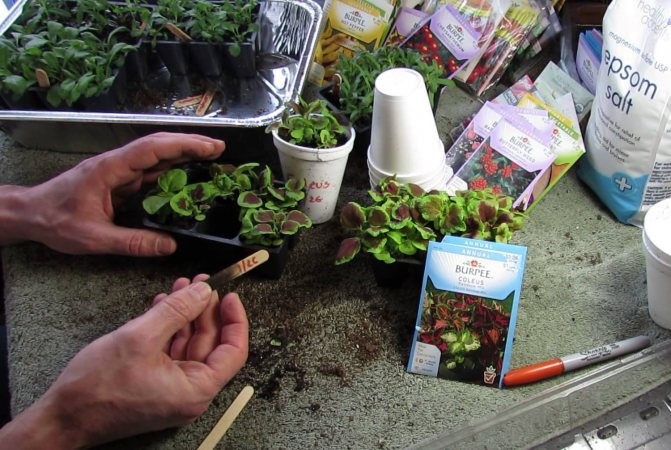

Further, the plant needs regular watering, diffused sunlight.
The flower can be transplanted to a permanent place in about six months.
Top dressing of seedlings
It is not difficult to grow Coleus from seeds. You can feed the plant 14 days after the pick. For this, special complex fertilizers are used.
In flower shops, you can easily pick them up. Before use, be sure to read the instructions.
The dosage should be reduced by 3 times. Be sure to water the plant before fertilizing. Otherwise, you can burn the roots of the Coleus.
Reproduction of Coleus by cuttings at home
There are several ways to reproduce this flower. Seed propagation is quite laborious and requires special skills, so most gardeners prefer growing nettles from cuttings.
For this it is recommended:
- Choose a branch that is suitable for the cutting - it should have at least two formed leaves;
- Carefully cut it off with a clean tool and place in a previously prepared container with clean water at room temperature;
- After a couple of weeks, the first roots will appear at the edges of the cuttings. Wait until they grow up a little;
- Prepare a small container with a moistened substrate and plant the cuttings in it.
Since this is a rather unpretentious flower, the planted stalk is already an independent young plant that does not need particularly close care. You just need to ensure that he receives a sufficient amount of light and moisture.
For even more useful information on plant braking, see the video:
Features of caring for Coleus in the open field
The flower is transplanted to a permanent place towards the end of June. In the open field, caring for Coleus is also not difficult.
The plant needs to find a good place on the site, provide regular watering, fertilize and, if necessary, prune.
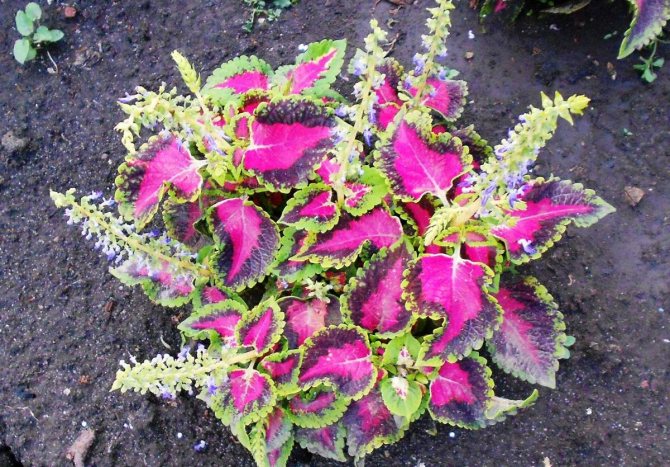

Choosing a landing site
Landing the Coleus in a permanent place is possible only in warm, stable weather. There should be no frost at night.
This also applies to the soil, it should warm up well. It is important to leave enough room for foliage to form.
After about 3 months, Coleus grows widely. Thus, at least 25-30 cm is left between individual seedlings.
Site requirements:
- lack of stagnation of water in the soil;
- good lighting;
- no strong gusts of wind.
Considering these requirements when choosing a site for a flower, in the future you will get a colorful healthy plant that will decorate any flower bed or flower garden.
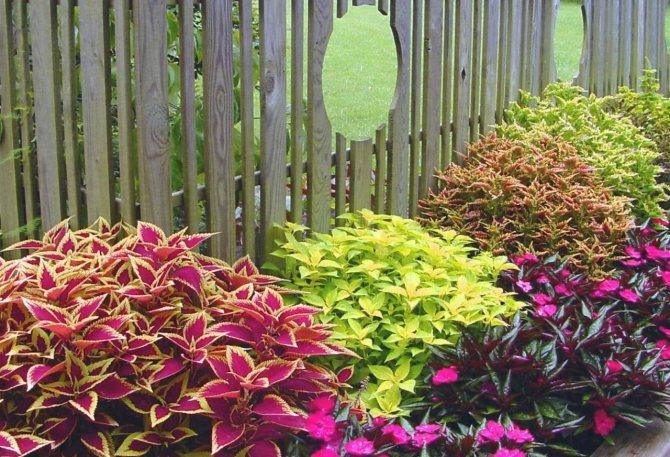

Soil requirements
The soil for the Coleus must be fertile. For the rapid development of a flower, nitrogen is needed.
If the soil is too heavy and loamy, it is recommended to add sand and peat. It will become looser and lighter.
It will be easier for oxygen to penetrate deep into the soil. It is necessary for the growth of coleus.
How to water a plant
Coleus in the open field requires a regular supply of moisture. Watering is very important to him.
The earth must not be allowed to dry out!
Watering is best done in the evening.
It is recommended to use warm water for irrigation.
Water the plant less if the outside temperature drops.
Under the condition of indoor cultivation in winter, watered when the soil from above becomes dry.
Coleus feeding rules
Coleus will be an ideal option for decorating a site. Growing an unpretentious plant does not require much effort.
The flower grows and develops beautifully even without top dressing. However, if it is fertilized it will only benefit him.
It will become more voluminous and stronger. You can buy fertilizer at a flower shop. Each package contains instructions for use.
It is imperative that you familiarize yourself with it and calculate the dosage. Fertilizers need to be applied during the growing season.
Nettle is fertilized once every 10 days.
Please note that at this stage, the dressings contain as little or no nitrogen as possible.
The fact is that nitrogen affects the colorfulness of the foliage - they become less bright and clear.
How to give Coleus a compact shape - pruning
Pinching the flower is required if it is necessary to give it a more compact shape.
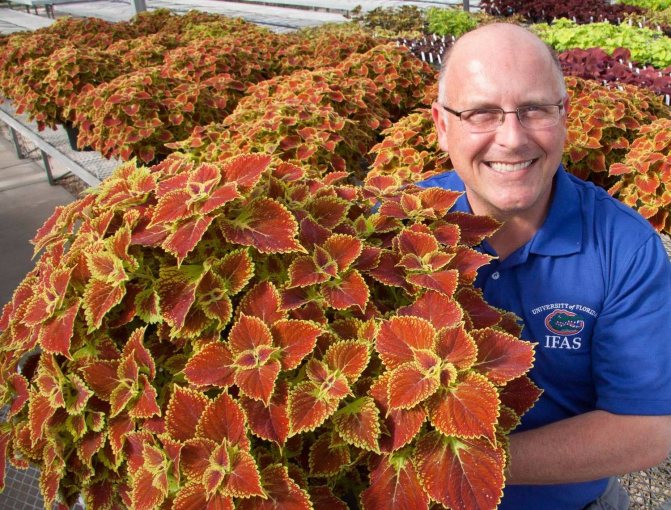

Without pruning, the height of the nettles will be greater, as the bush will grow upward.
To give it a spherical shape, the lateral and upper kidneys are removed.
The flower tolerates pruning well, does not get sick.
That is why even small bushes can be pinched.
Pruning can be started when the plant has reached a height of 5 cm, while the side branches should be about 4-5 cm.
Mr. Dachnik informs: the use of Coleus Blume and its psychotropic properties
The indigenous people of southern Mexico claim that the leaves of the bush have a mild, relaxing and hallucinogenic effect. Modern science has not proved this fact, the psychoactivity of the plant has not been fully studied.
There are cases when people felt some changes in consciousness after chewing the leaves and brewing tea. Nevertheless, there is no reliable information to date.
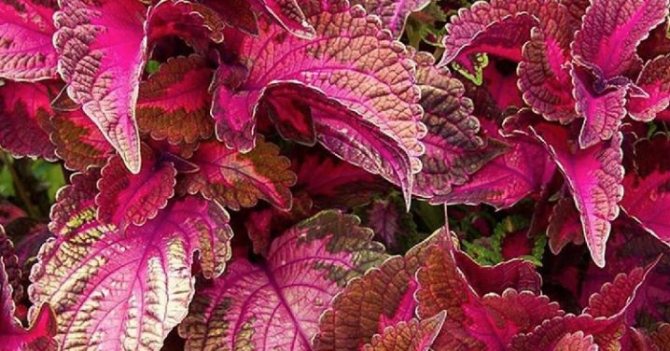

Coleus is the type of plant that is characterized by beauty, rapid growth, endurance and ease of care. Coleus Blume, which is a hybrid presented in various forms and varieties, has earned widespread and recognition.
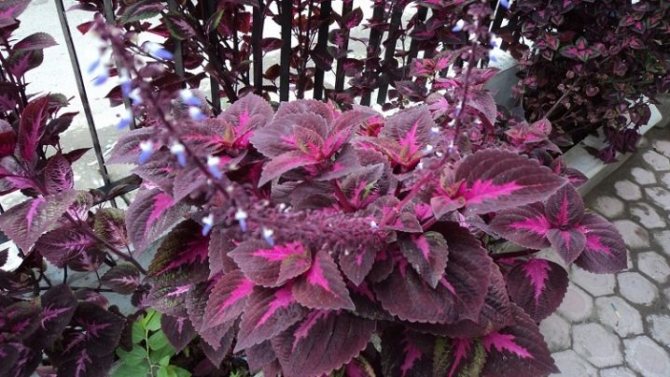

Plant diseases and pests
The Coleus plant is an unpretentious plant that is not demanding on the composition of the soil and top dressing. But sometimes it happens that various pests can attack it.
Also, a weakened flower with improper care can be affected by a disease.
The most common pests include:
- whitefly;
- aphid;
- spider mite;
- mealybug.
Dealing with pests is in any case more difficult than preventing their occurrence. For prevention, you need to dust the bushes with wood ash.
Spraying plants with soapy water is also a good way to control pests. It is especially effective against aphids and whitefly larvae.
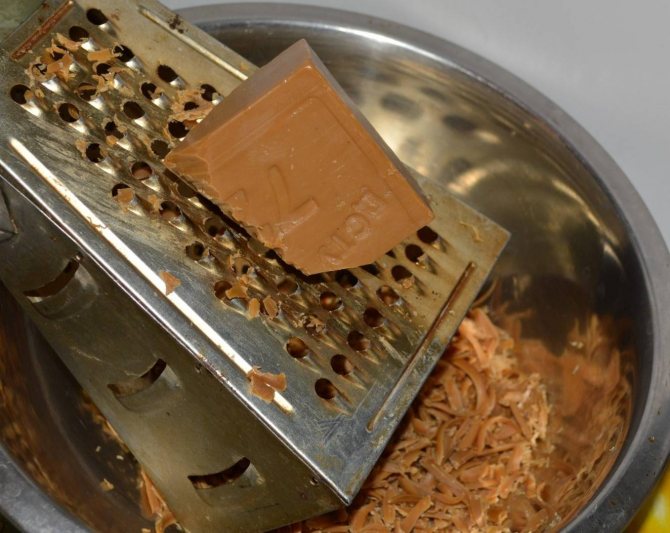

You can prepare a solution according to the following recipe:
- Laundry soap is grated.
- Warm water is poured into the container.
- Grated soap is added there.
- For 1 part of the soap, take 6 parts of water.
A citrus infusion will help get rid of the mealybug.
For this, lemon, orange, tangerine peels are suitable.
It is necessary to pour 50 g of zest with boiling water and insist for a day.
Affected plants are sprayed with the resulting solution.
Remember that all procedures are carried out in dry weather.
This is best done in the evening or early morning. Otherwise, in the scorching sun, plants may get burned.
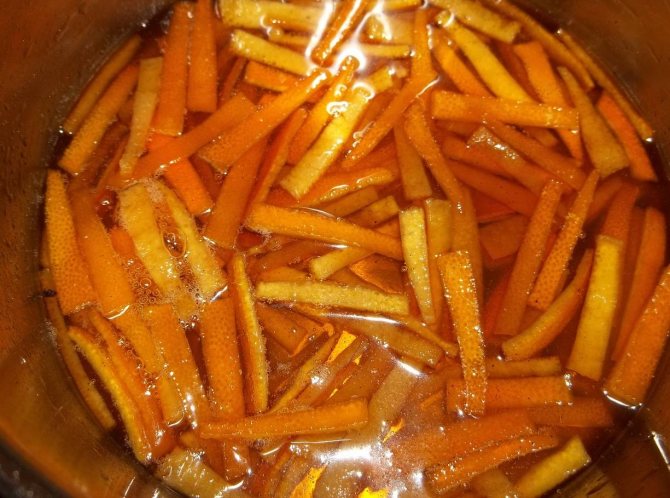

Rot and downy mildew are distinguished from common diseases of Coleus.
Diseases appear due to non-compliance with the watering regime. Also, the situation is aggravated by temperature drops.
When various spots appear on the leaves, it is necessary to spray the plant with special agents.
You can use a fungicide. The instructions are on the packaging.
It is also important to remove all damaged parts of the wheel. In order to prevent harmful substances from entering the soil, it is necessary to cover the soil around the plant with a film before spraying.
Growing coleus seeds
Growing coleus with seeds is a more laborious process, but if you follow all the rules, it is quite doable. Before sowing seeds, it is imperative to check them for germination.
Place the planting material in a container with water and see which seeds have sunk to the bottom and are suitable for sowing.
Growing Coleus seeds is no different from the usual getting seedlings of any other crops.
The seeds are sown in a flat box with soil and sprinkled with 2 cm thick sand on top. The room temperature should not fall below 20C, so it is better to cover the box surface with polyethylene.
After spiking the planting material, it is dived, transplanted at a distance of 2 cm from each other. It is very interesting to observe the emergence of sprouts, with each new leaf the colors on the leaves appear more and more wonderfully, and the shape of the sprouts is transformed.
Types and varieties of coleus with photos and names
Currently, there are more than 200 species and varieties of coleus. Among them there are annual and perennial representatives.
They all differ in leaf color and height.
The best varieties for the middle lane
A huge variety of species and varieties of plants allows you to choose the ones you like the most.
Someone prefers the Evening Dawn variety with bright red leaves or a black dragon with dark purple foliage.
Other gardeners will like the Coleus Russian size. Of all the varieties, it has the largest variegated leaves.
In addition, there are many more interesting specimens.
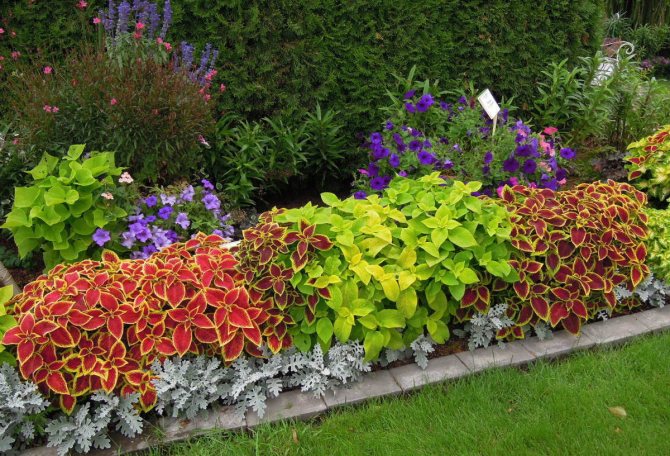

Coleus hybrid (Coleus x hybridus, Giant Exhibition)
Coleus hybrid grows from 50 to 80 cm. Leaves are red, purple, green.
They are slightly pubescent, wide. When blooming, you can see a dense brush.
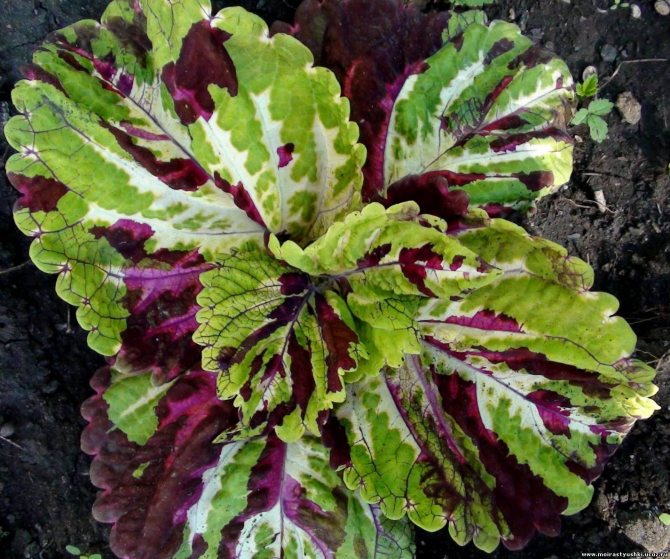

Coleus rehneltianus
Coleus Renelta came to us from Sri Lanka. It differs in ampelous shape, drooping stems.
During flowering, blue inflorescences are formed. When grown at home, it blooms closer to winter.
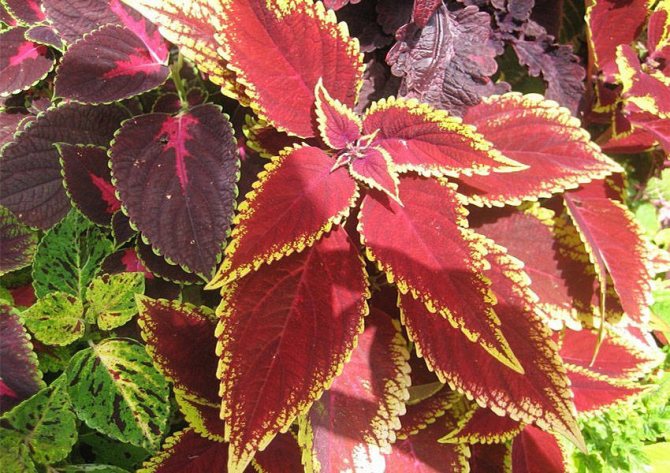

Coleus blumei
Coleus bloom is a herb that is grown as a perennial. Its height can reach 80 cm.
The color of the leaves is varied. These are plants with purple, brown, even almost black leaves.
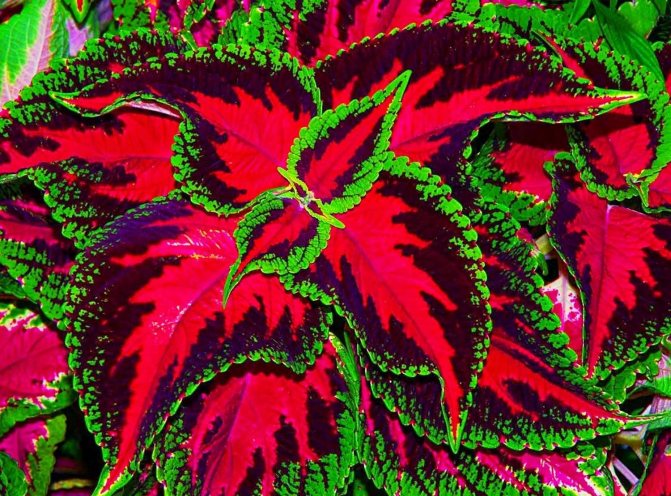

The original plant can have a wide variety of colors. Variety Scarlet heart or black star.
Unique variety Black dragon. It has dark purple leaves that look like corduroy.
Coleus black dragon grows from 30 to 35 cm tall, suitable for growing at home and in the garden.
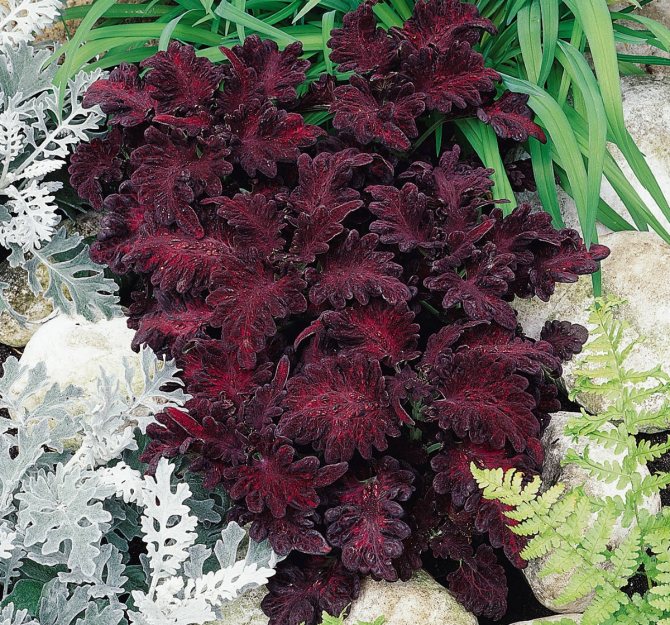

An interesting plant is the dog Coleus (Coleus caninus). It is capable of emitting a smell that cats do not like extremely. It is a low-growing variety up to 15 cm tall.
Coleus wizard is a compact plant that is often used to decorate borders.
The flower is also perfect for growing at home or on the site. Coleus Wizard perfectly tolerates bright sun and hot weather.
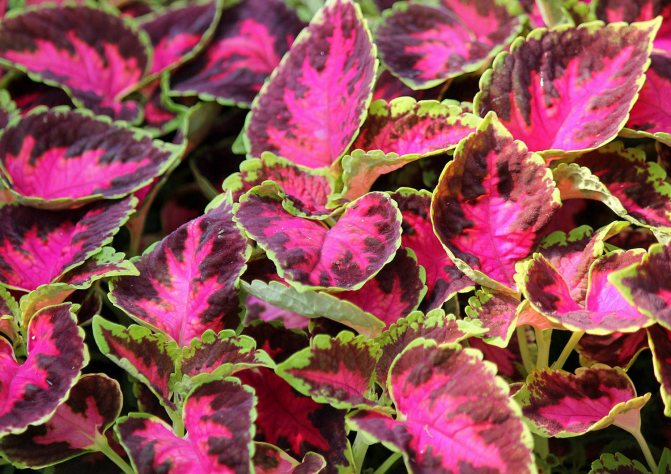

Varieties
- ‘Golden Bedder’ - yellow leaves;
- ‘Henna’ - leaves with fringed edges;
- ‘Salmon Lace’ - red leaves with a green border;
- 'Butterfly' - wavy leaves;
- ‘Volcano’ - dark red leaves;
- ‘Saber’ - mosaic leaves with a raspberry-cherry center and light green irregular border;
- ‘Red Head’ - small fringed leaves of scarlet color;
- 'Versa Lime' - lime-colored leaves;
- 'Fishnet Stockings' - light green leaves with purple-purple veins;
- 'Salmon Pink' - Light pink center and veins with green edging.
Popular varieties:
- Mix of colors - the variety is grown as an annual. Height 50 cm. Leaves 5-7 cm long, heart-shaped, greenish-yellow, bronze and combinations with red shades.
- Fun - height 20-25 cm, a mixture of colors with a split edge.
- Wizard - height 30-35 cm, mixture of colors.
- Tenderness - height 30-35 cm, light pink center with lemon border with green splashes.
- Orange - height 15-20 cm, orange with lemon border.
- Evening dawn - height 30-35 cm, red.
- Rainbow - height 30 cm, mix, center red, border shades of green.
Series Wizard:
- Scarlet Wizard - height 30-35 cm, dark red with a light green border.
- Wizard Velvet - deep red with light teeth at the tips of the leaves.
- Wizard Golden - height 50 cm, lemon-colored leaves.
- Scarlet Wizard - brightly colored velvety leaves, scarlet in color with a lemon border.
- Wizard Sunset is a cultivar with orange leaves with light teeth at the tips of the leaves.
- Wizard Rose - height 20-25 cm, tricolor, the center of the leaf is crimson, with two edging lemon and light green.
- Wizard Mosaic - height 20-25 cm, two-color, green interspersed with burgundy.
- Wizard Golden - height 50 cm, yellow.
- Wizard Jade - yellow center with green border.
- Coral Wizard - tricolor leaves, coral middle, brown-green border.
- Magic Jade Wizard - with a white center and green border.
Photos and videos about the combination of coleus with other plants
The variety of plant varieties allows Coleus to be widely used in the garden. The flower is ideal for creating flower gardens.
Coleus in landscape design will be a wonderful background for roses. It can also be used for joint planting with sage, silver cineraria, fescue.
You can often see a colored carpet from different plant varieties in city parks.
Nettle is combined with other plants that are similar in color, height or foliage shape.
You can dilute a flower bed with bulbs by planting a colorful plant among them. It will certainly attract the attention of all guests.
Planting coleus on your personal plot is an excellent solution, since the flower is unpretentious, bright and very beautiful!
Features of the
Coleus Blume is a representative of bright ornamental plants, the main feature of which is the aesthetic value of leaves, not flowers. The foliage of the plant is characterized by velvety, it is painted in different color shades. This representative is considered indoor dweller, but can feel great in the garden.
The perennial plant is classified as clear-flowered and labiate, it has a fleshy stem, which becomes woody over time. In height, the Blume Coleus can reach 0.1-0.8 meters. The dimensions of the flower are influenced by the peculiarities of caring for it. Each type of variety has a different foliage shape, which can be elongated, oval, cordate and have jagged edges. The color of the foliage of the shrub is different, it is brown, red-burgundy, dirty orange and even almost black.
The flowering period of the shrub falls on the spring-summer period, at which time lilac-lilac small flowers appear on the Coleus, having a two-lipped corolla and a spike-shaped inflorescence. Among the people, Blume is also called room nettle, thanks to the characteristic shape of the foliage.
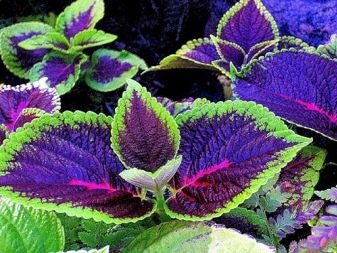

Growing Coleus from seeds
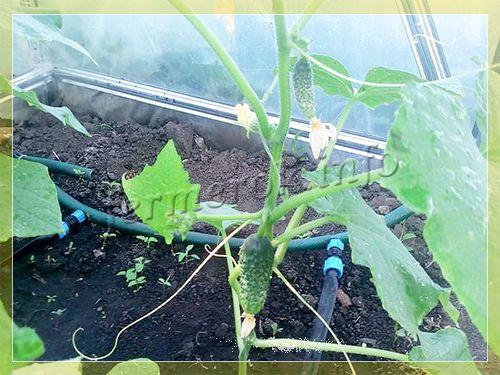

Coleus is propagated by two main methods - cuttings and seeds. The easiest way to reproduce is by seeds. It is also the most affordable, since not everyone has access to the mother plant to cut the cuttings.
The seeds are sown in March. The method of surface sowing is used - the seeds are not buried, but simply pressed. At a temperature of + 20 ... + 24 degrees Celsius, they quickly germinate in about 10-14 days. If seedlings are made, then a temperature of + 16 ... + 18 degrees will be enough for it. But in the case of seedlings, lighting is very important - it should be constant, warm, not very bright, without darkening.
When a bright, decorative pattern appears on the leaves, they can be planted in separate pots or in an area. After a while, when the bush is more than 4 cm in height, and the side shoots are from 3 to 4 cm, they pinch the top and side shoots - at the level necessary for the grower (depending on the size of the plant you need). When new shoots appear, they are also pinched - so that a beautiful bush is obtained, and not a sprout with pagons of different lengths sticking out in all directions.
Where is the best place to keep the flower
To make the Coleus feel comfortable, before buying it, you need to think about the future location of the handsome man.Since it has its own "character", it is worth setting aside a window sill for the plant in the kitchen, study or living room. The flower does not like to be disturbed, so you should not constantly rearrange it from place to place.
So that the attractive color does not disappear from the leaves, the nettle should be placed in a well-lit room. And according to feng shui, the plant should be placed in the zone of knowledge and wisdom - the northeastern part of the apartment.
If there is a schoolchild in the family, then the Coleus can be placed near the table at which he prepares his lessons. Nettles will give you mental clarity and help you remember your homework better.
Feng Shui teachings say that with the help of a plant, you can eliminate the negative in living quarters as much as possible. For this, the corners of the rooms are decorated with Coleus, where negative energy accumulates.
It is very difficult not to touch the bright red-brown leaves, bordered with emerald green. They are covered with silky hairs that allow them to retain moisture and receive information from the surrounding space. For these hairs, the flower was popularly called "decorative nettle".
Description of the plant
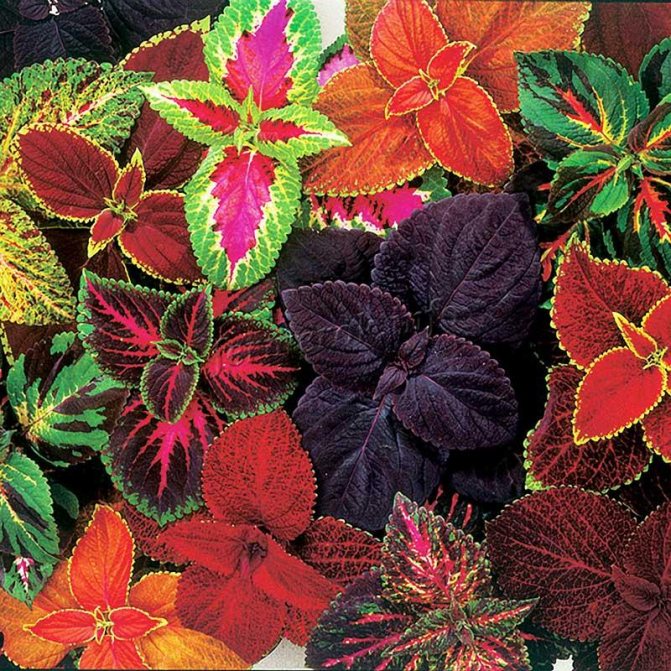

Coleus is the Latin name for the plant. It is popularly called nettle because the flower in its natural environment resembles a little nettle, but with bright leaves. Belongs to the genus of evergreens, perennials from the labiate family. His homeland is considered to be Africa and Asia. The flowers are nondescript, simple, but they smell nice.
The height of the culture can be different and depends on the species, variety, place of growth. It has a strong stem, and it is usually stiff at the base. Leaves are the main quality of the plant. They are cordate, serrated along the edges. They are the most decorative, aesthetic part of the culture. The color of the leaves can be very diverse: burgundy, purple, red, yellow, brown, green, with spots or stripes. The color can be one or two, sometimes more.
Watering and moisture
Do not forget that Coleus loves abundant watering not only in spring and summer, but also in winter, on a warm sunny windowsill in a dry room, you need to make sure that the soil in the pot does not dry out. But if in the light and in the warmth, Coleus is watered abundantly, then in cool conditions and darkened rooms, watering is halved. A temporary drought will do less harm than an excess of moisture! When a plant is thirsty, its leaves droop. In addition, at high temperatures, the flower loves to be sprayed. But you should not wipe the velvet leaves. In spring and summer, once every 2-3 weeks, you can feed the Coleus with fertilizers, although watering and sunlight are enough for the normal development of the plant.
It may be interesting: Tillandsia epiphytes: atmospheric, usneiform and others
Coleus transplant
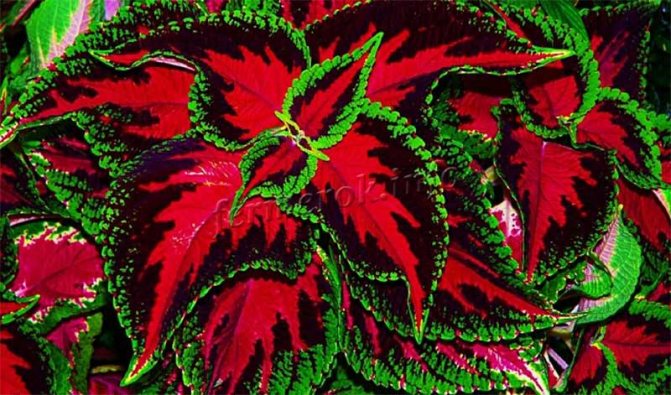

Coleus is usually transplanted in the spring. During transplantation, you can not especially think about the type of soil, since the Coleus feels great both in sod or leafy soil, and in the garden. If the transplant is carried out in a pot, and not on a flower bed, but you need to select a larger one in size by 3-5 cm.
They plant the plant deeply - this allows the culture to grow additional roots and develop its root system. When transplanting, the stems and roots are pruned a little in order to accelerate the survival rate in a new place. At the same time, it is very important to sprinkle the cuts with crushed charcoal.
Notes (edit)
Coleus Blume is suitable for shaping a tree. It does not matter whether to start forming with small seedlings or later. You can start with a plant selected for wintering to get cuttings for the next year. In any case, you need to decide and choose one fairly simple escape. From the old plant, the lower leaves and side shoots are simply removed to the required height, highlighting the cuttings used for seedlings, the lower leaves are removed from the cuttings, if necessary, they are transplanted into a larger pot.When forming an older plant, like seedlings, a bamboo stick is installed, placing the support closer to the trunk. In the older plant, we attach the support moderately freely, in several places, in the seedlings, as the shoot grows, systematically removing the lower leaves, possibly lateral shoots.
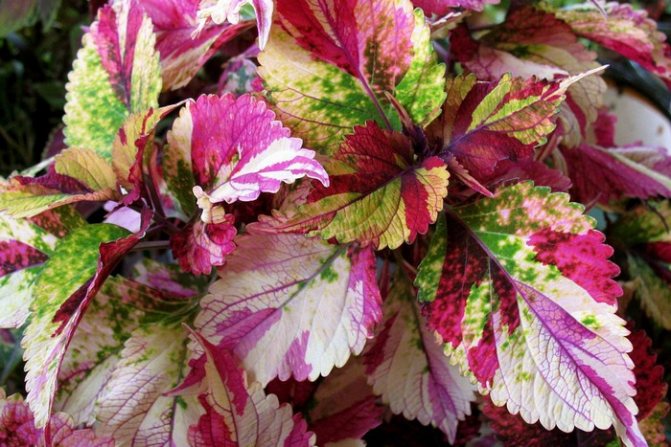

When the coleus grows 80-90 cm high, you must either transplant or put the pot in a large container to maintain balance. Leave the trunk height of about 60 cm, cut off all the time, gradually growing shoots. Then cut off all side shoots and the main shoot. The emerging shoots are cut off again after the second pair of leaves. Shoots do not grow too evenly, pruned to maintain the shape of the crown of the tree. During the entire time, everything is removed from the trunk, up to complete lumber. A formed tree can live for several years under favorable storage conditions, or choose another specimen for formation in February-March.
| Scarlet | Light green border with burgundy center. |
| Mosaic | Bard spots on a green leaf. |
| Jade | Yellow center with green edging. |
| Coral | The middle of the coral color is framed by a brownish-green outline. |
| Magic Jade | Lettuce edge with a white core. |
| Velveteen | A dark red leaf is bordered by a light stripe, a carved outline. |
| Golden | Yellow saturated shades. |
| Scarlet | Red with lemon border. |
| Sunset | Orange leaf with light edging. |


